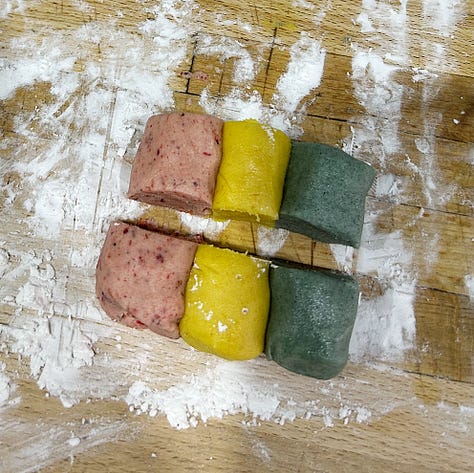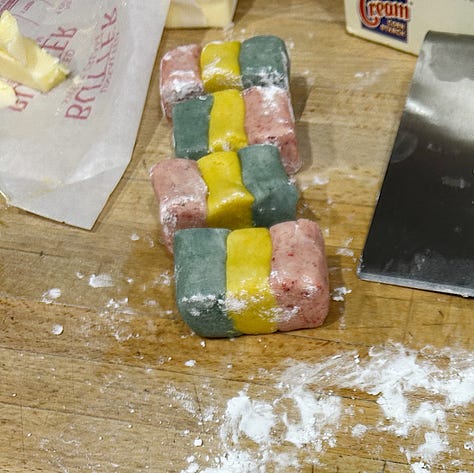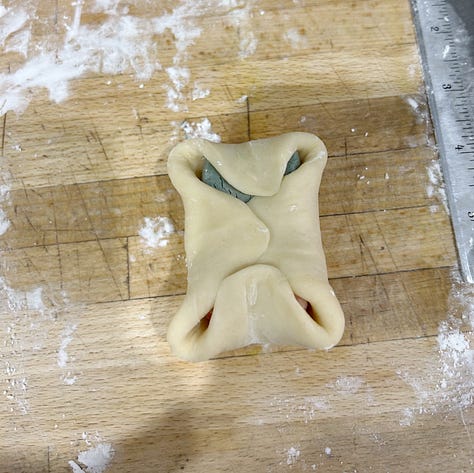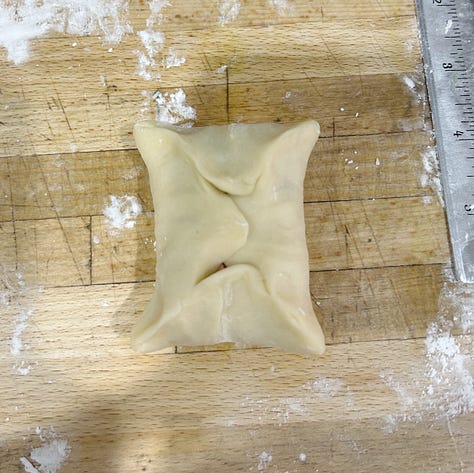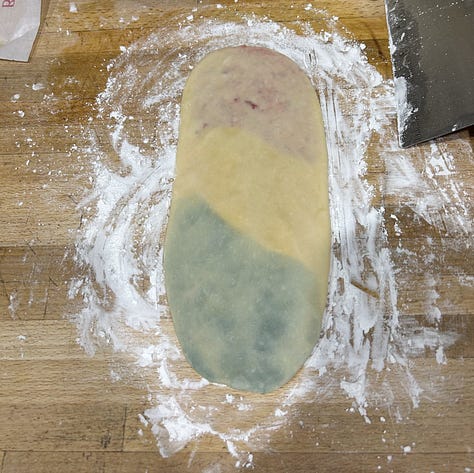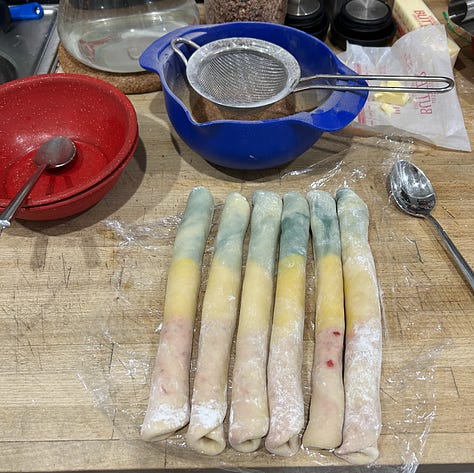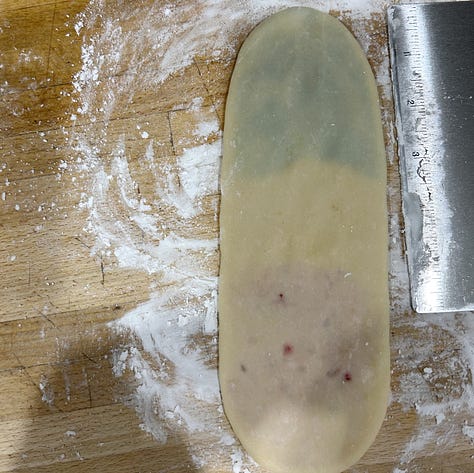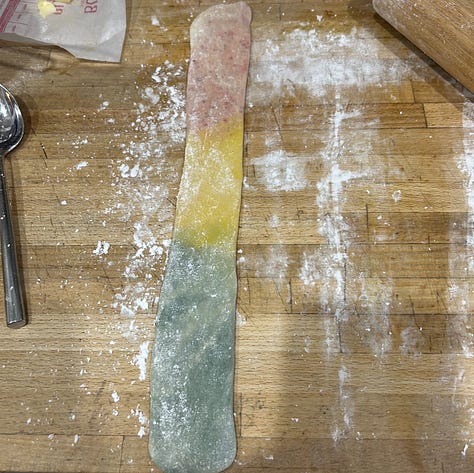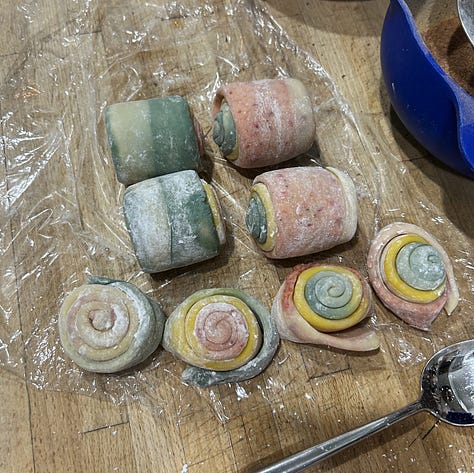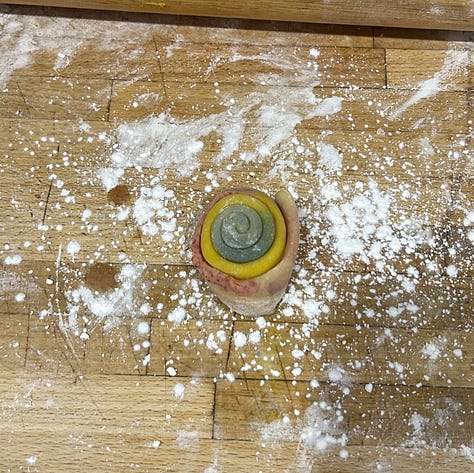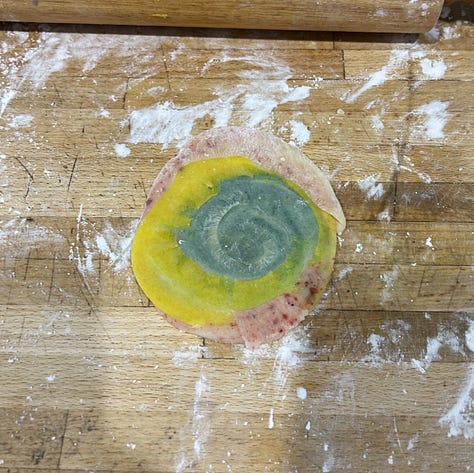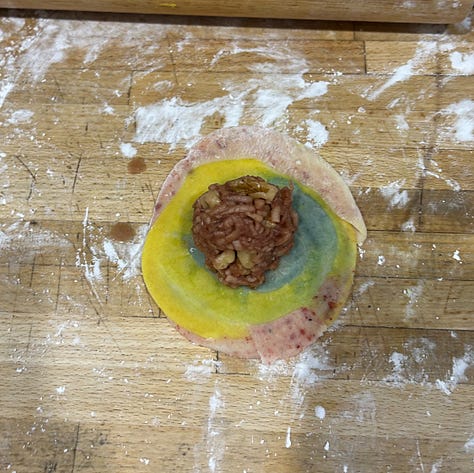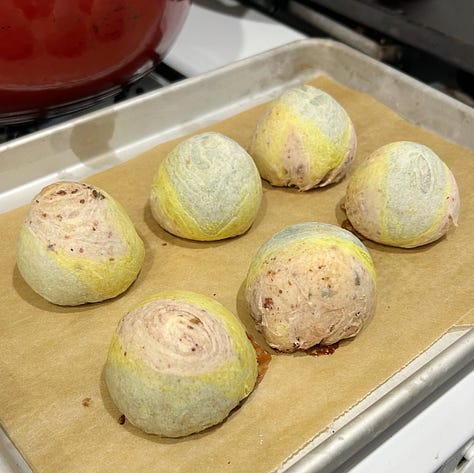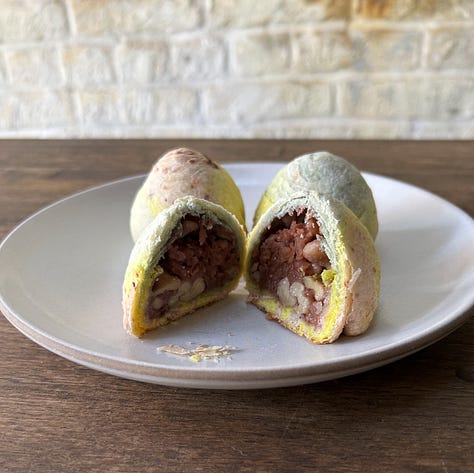Vol. 5, Part 2: From the Table of Holiday Traditions (Spring Interlude)
Charoset Easter Egg Pastries
During the handful of years I lived in LA, time moved differently. The slower pace of the city and subtle changes in weather from one season to the next made it feel to me as if time stood still. I longed for winter snows and the brave new spring leaves venturing forth from bare soil and branches. Marking the passage of time took on a new importance as I learned the markers of the subtler change in seasons.
Similarly, since I married into a different set of traditions than the one I grew up in, embracing holidays, both my husband’s family traditions and mine has taken on much more importance as a way to mark the passage of time.
As an adult, I don’t closely follow the religion I grew up in, but I value the holidays and traditions even more as a way to connect with my family and to my own history within my marriage. It’s as important as learning and celebrating the traditions that my husband grew up with and values.
When approached with respect and a little playfulness, it’s a lovely place to create our own traditions that are meaningful to us. I like to find moments to combine aspects of his Jewish and my Catholic traditions to make something that feels like a meaningful way for us to celebrate both.
In the history of Catholic holidays, there’s a long history of incorporating aspects of other traditions as the religion spread to new communities. (There’s also a sordid history of using holiday traditions for religious persecution, as during the Spanish Inquisition.) The current iterations of Christmas and Easter combine so many aspects of pre-existing winter and spring rituals, incorporating regional traditions based in other faiths.
My purpose differs. I appreciate the spirit of combining traditions to find common grounds for celebration and to build community. Life is so much richer and more interesting when we can celebrate and share our backgrounds and values as individuals in community, when we can use them to grow something greater together.
Since Easter falls at the end of Passover this year, I’d like to leave you with a sweet, delicately flaky little pastry that celebrates both. I wrapped charoset in a flaky, pastel swirled laminated pastry dough to make little Easter Egg-shaped apple dumplings. The dough is borrowed from a Taiwanese taro cake (sometimes called spiral mooncakes). It uses a brilliant method of laminating a butter-based dough with pastry dough for nearly fool-proof lamination. With the colored doughs being about the texture of Play-Doh, making these feels like child’s play. It’s much less sensitive to warmer room temperatures. (I made my last batch while I was baking my weekly sourdough boule.) You can use leftover charoset from Passover Sedar, if you like, to take advantage of the depth of flavor that only comes after the apples and walnuts have been soaking in wine for a while. I used apple-based charoset, but I think that that a Sephardic-style charoset would be equally delicious. Eat them warm from the oven, or room temperature at Easter brunch. Either way, they are an arguably tastier alternative to the absurdly expensive eggs this year than dyed potatoes.
For an interpretation of latkes that I crave as much for a Spring brunch as for Hannukah, try my recipe for Dill Pickle Latkes with Lox and Labne in Vol. 5, Part 1. They taste like a hot German Potato Salad that walked into a Jewish deli, fell in love with a Dill Pickle, and had a little Latke with Lox baby — all in good fun if you’re willing to bend tradition and borrow from a mashup of my food memories.
An Invitation to Write
What traditions are important to you?
How has that changed over time?
Charoset Easter Egg Pastries
Are you celebrating Passover and Easter? Have some leftover charoset from your Passover Seder? Consider making a dozen flaky, little pastries instead of dyeing eggs. Served warm from the oven or at room temperature, they have all the flavor of apple dumplings in a delicately swirled, pastel package — perfect as a sweet addition to Easter brunch.
I adapted the pastry recipe and technique from Mandy Lee of Lady and Pups’ Pastel Easter Egg Pastries, based on Qiong Cooking’s recipe for the Taiwanese taro cake, yutousu, also called spiral mooncake. The 2 dough method makes for an easy laminated dough that is easy to layer even in a warm kitchen. With the colored dough, it feels a bit like baking with Play-Doh!
After making a round of her pastry eggs a couple of years ago using tiny lady apples cored and stuffed with cinnamon and sugar like a Pennsylvania Dutch-style apple dumpling, I knew I wanted to try these stuffed with charoset to make during the years when Passover and Easter overlap.
Notes: The bland, floury flavor of the pastry dough reminds me a lot of matzo. While it is an unleavened dough, this is technically not Kosher for Passover. Keep that in mind as you plan. If you would like a pastry dough with a little more flavor, increase the salt to about 1/2 teaspoon (5g) in the water dough, or use salted butter.
For food coloring, I used colorful food-based ingredients I had in the kitchen, but feel free to use what you prefer, just make sure that it is concentrated enough to impart the amount of color you would like without adding more than a couple of drops’ worth of water. Here’s what I used for delicate pastel colors:
Yellow: ~1/4 tsp turmeric
Red: ~2 tbsp freeze-dried strawberries crushed to a powder
Blue-Green: ~1/4 tsp spirulina powder
For the filling, you can use ~1 1/2 - 2 cups of leftover charoset with 1 tbsp cornstarch added to allow it to thicken as it bakes, or use my recipe below.
Makes 1 dozen
Prep Time: ~2 hours
Ingredients for Pastry Dough:
1 cup + 2 tbsp (170g) all-purpose flour
2 tbsp (25g) sugar
a pinch of kosher salt
2 tbsp (28g) unsalted butter, room temperature
1/3 cup (80g) water
Ingredients for Butter Dough:
2/3 cup (100g) all-purpose flour
6 tbsp (85g) unsalted butter, room temperature
food coloring
cornstarch (to flour your counter)
Ingredients for Charoset Filling:
1 lb (2-3 medium) apples
1/2-1 cup (75-125g) chopped walnuts, toasted if you like
2 tbsp Manischewitz, sweet Passover wine, ruby port, or pomegranate juice
2 tbsp brown sugar (or more to taste)
1/2 tsp cinnamon
a pinch of kosher salt
1 tbsp cornstarch
Special Tools:
Medium and small mixing bowls (I prefer having cereal-sized bowls to mix the colored butter doughs separately)
Ruler (or bench scraper or rolling mat with measurements)
Bench scraper or sharp knife (for cutting dough)
Rolling pin
Baking sheet
Parchment paper or a baking mat
Preparation:
Make the pastry dough. Drop the flour, sugar, salt, butter, and water into a medium-sized mixing bowl. Smush the ingredients together between your fingers to incorporate them into a rough dough. As the butter mixes into the dough, start using your whole hand to roll the dough around the bowl, gathering up any flour that might be sticking to the sides. Knead the dough in the bowl for roughly 5 minutes, until it is smooth and elastic. Cover the dough in plastic wrap or an airtight container and let it rest in the fridge while you make the filling and the butter dough.
Make the charoset filling. Peel your apples and grate them into a medium-sized mixing bowl. Grating the apples makes them easier to smoosh into a ball of filling later. We’re really looking to mimic a rough mortar here. Add the chopped walnuts, Manischewitz, brown sugar, cinnamon, salt, and cornstarch. Stir well and set aside to soak while you finish making your dough.
Make the colored butter dough. In a small mixing bowl, squish the butter and flour together between your fingers until it’s thoroughly incorporated. Then, use your hand to knead the dough in the bowl until it’s about the consistency of Play-Doh. Divide the dough into evenly into pieces equal to the number of colors you would like. Place each into a separate bowl. Knead a little food coloring at a time into each piece until you reach a shade you like. You will be layering the colored doughs with the pastry dough, so aim for a level of saturation about twice what you would like to see in the final pastry.
Create 6 rainbow blocks of butter dough. Lightly flour your work surface or rolling mat with cornstarch. One at a time, roll the colored butter doughs into 6 inch logs. Line them up, side by side. Then cut all of the logs into 6 even pieces. Take one block of each color and gently push them together, to form a striped rectangular block of colored butter dough. Flatten each side of the block against the work surface, to make sure the colored block stays together, then set aside. Repeat with each of the remaining colored dough blocks. You’ll have 6 rainbow color blocks in total.
Envelope the butter dough blocks in pastry dough. Divide the chilled pastry dough into 6 even balls. On your lightly cornstarch-floured work surface, roll the first ball into an oval roughly twice the length and width of one of your rainbow blocks (roughly 3x6 inches if you are using 3 colors). Place a rainbow block in the center of the pastry dough oval and gently stretch the sides of the pastry dough over the block, to create an even layer of pastry dough around it. Pinch the sides together to completely envelop the block, then set aside, seam side down. Repeat with the other 5 dough balls and blocks.
Roll out each block into a long rectangle. Then roll into a striped log. Place the first covered dough block back on the workspace. Roll it out lengthwise to a roughly 6-8 inch rectangle. You’ll see the colored stripes through the pastry dough as you roll it out. Roll the dough rectangle into a log along the colored stripes and set aside. Repeat with the other blocks.
Roll out each log into a 12 inch strip. Then form into a swirled snail. Place the first log back on the workspace and roll it out lengthwise into a long strip roughly 12x2 inches. Fold it in half lengthwise. Roll it tightly from one end to the other into a swirled snail of dough. The color of the end you start rolling the snail will become the color at the top of your egg. Repeat with the other logs, setting each aside.
Cut each snail in half. Roll into a circle of dough, and fill. With a sharp knife, cut each snail of dough like a bagel into circular halves. Set a circle, cut side down, on the work surface. Roll it out into a circular disk about 4 inches in diameter. Take a generous spoon (about 2 tbsp) of charoset, squishing it firmly into a ball in your hand and letting any excess liquid drain away. The final ball will be roughly the size of a walnut or golf ball. Place in the center of the dough circle, drawing the edges around the ball of charoset to enclose it, pinching the ends together firmly so that none can seep out. Gently shape the ball into an oblong egg shape, with the pinched end at the bottom of the egg. Keep in mind that the shape will relax toward the bottom as it bakes, so aim for a slightly elongated egg shape. Set aside, pinched side down. Repeat with all of the other snails. You will have 12 eggs in total at the end. If you like, you can put the eggs gently into an airtight container and store in the fridge to bake another day. They can be baked straight from the fridge.
Bake at 350 F for 25-30 min. Preheat your oven to 350 F. Line a baking sheet with parchment paper to catch any filling that might seep out as the eggs bake. Space the eggs evenly, pinched side down on the parchment. Bake for 25-30 min on the middle rack until your kitchen starts smelling like apple pie and the tops of the eggs just start to brown slightly.
Let the eggs cool for a few minutes before serving. Serve them warm or at room temperature. Leftover pastry eggs can be stored in the fridge for about a week.
